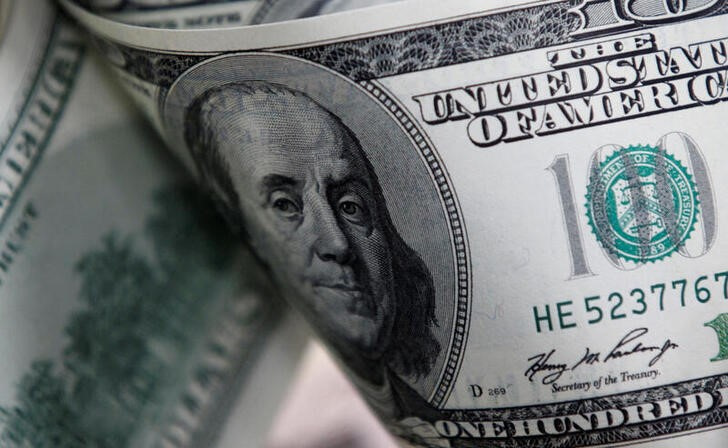Forex
Dollar reaches one month high as sentiment nervous , pound jumps on inflation data


© Reuters. FILE PHOTO: U.S. one hundred dollar notes are seen in this picture illustration taken in Seoul February 7, 2011. REUTERS/Lee Jae-Won/File Photo
By Alun John and Brigid Riley
LONDON/TOKYO (Reuters) -The dollar hit a one-month high against a basket of its peers on Wednesday as the safe haven gained on the hit to sentiment from soft Chinese data and global rate setters arguing against imminent cuts, while sterling rose on higher British inflation.
The reached 103.58, its highest since December 13, extending gains after a 0.67% jump on Tuesday. It was last up a fraction on the day at 103.34.
That jump was driven in part by the Federal Reserve’s Christopher Waller saying that while the U.S. is “within striking distance” of the Fed’s 2% inflation goal, the Fed should not rush towards cuts in its benchmark interest rate until it is clear lower inflation will be sustained.
Market expectations of a rate cut in March have eased to around a 60% chance versus roughly a 75% view in the prior session, according to CME’s FedWatch Tool, and U.S. yields rose. [US/]
Also in the mix was data showing China’s economy grew 5.2% in 2023, slightly more than the official target, but it was a far shakier recovery than many analysts and investors expected.
Some December indicators released along with the GDP data were more grim, suggesting the country’s protracted property crisis is deepening.
That weighed on Asian and European shares, and the broader market mood. [MKTS/GLOB]
“A combination of weakish China data and a pushback by both ECB and Fed officials against early easing is weighing on risk sentiment and supporting the dollar,” said Chris Turner global head of markets at ING.
“It is hard to see that sentiment changing today should US December retail sales come in on the strong side.”
That data is due at 1330 GMT, and will give the latest indication of the health of the U.S. economy.
The dollar traded at its highest since early December against the rate-sensitive Japanese yen, last up 0.3% at 147.64, while the China-exposed Australian dollar hit its lowest since Dec. 12 and was last down 0.3% at $0.6564.
The dollar also hit a new two-month high of 7.2282 on China’s .
The euro was flat at $1.0819, steadying after a 0.7% drop on Tuesday after Waller’s remarks, as comments from European Central Bank policy makers also pushing back on imminent rate cuts in Europe helped put a floor under the euro.
Investor bets for ECB rate cuts are excessive and possibly self defeating because they could actually hold back monetary easing, Dutch central bank chief Klaas Knot told CNBC on Wednesday.
The pound was the exception in climbing on the dollar, up 0.43% to $1.2690, as a rise in British inflation data reinforced market expectations that the Bank of England will be slower to cut rates than other central banks.
The data “supports our view that whilst price growth is set to cool faster than the BoE had anticipated, continued economic resilience will prevent inflation from cooling at a pace that would justify rate cuts in the first half of this year,” said Nick Rees, FX Market Analyst at Monex Europe.
He said this would be supportive of the pound and “is likely to play out most clearly on crosses, particularly against the euro as is visible in the market response to today’s data.”
The euro dropped to a one-month low on the pound and was last down 0.4% at 85.73 pence. The pound was also up 0.8% against the Australian dollar at a four-month high., and up 0.7% on the yen.

 Forex3 years ago
Forex3 years agoForex Today: the dollar is gaining strength amid gloomy sentiment at the start of the Fed’s week

 Forex3 years ago
Forex3 years agoUnbiased review of Pocket Option broker

 Forex3 years ago
Forex3 years agoDollar to pound sterling exchange rate today: Pound plummeted to its lowest since 1985

 Forex3 years ago
Forex3 years agoHow is the Australian dollar doing today?

 Cryptocurrency3 years ago
Cryptocurrency3 years agoWhat happened in the crypto market – current events today

 World3 years ago
World3 years agoWhy are modern video games an art form?

 Commodities3 years ago
Commodities3 years agoCopper continues to fall in price on expectations of lower demand in China

 Economy3 years ago
Economy3 years agoCrude oil tankers double in price due to EU anti-Russian sanctions























